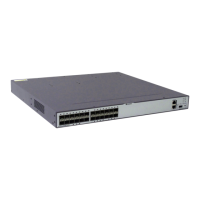When configuring manual aggregation of routes, you can apply various routing policies and set
the route attributes.
----End
8.5.4 Configuring BGP4+ to Import and Filter External Routes
After BGP4+ filters the imported routes, only the eligible routes are added to the local BGP4+
routing table and advertised to BGP4+ peers.
Context
Do as follows on the BGP4+ switch:
Procedure
Step 1 Run:
system-view
The system view is displayed.
Step 2 Run:
bgp as-number
The BGP view is displayed.
Step 3 Run:
ipv6-family [ unicast ]
The BGP IPv6 unicast address family view is displayed.
Step 4 Run:
default-route imported
BGP4+ is configured to import the default routes.
If the default-route imported command is not used, you cannot import the default routes from
other protocols by using the import-route command.
Step 5 Run:
import-route protocol [ process-id ] [ med med | route-policy route-policy-name ]
*
BGP4+ is configured to import routes of other protocols.
NOTE
Specify the process ID when the routes of a dynamic routing protocol are imported.
Step 6 Run:
filter-policy { acl6-number | acl6-name acl6-name | ipv6-prefix ipv6-prefix-name }
export [ protocol [ process-id ] ]
Imported routes are filtered.
After BGP4+ filters the imported routes, only the eligible routes are added to the BGP4+ local
routing table and advertised to BGP4+ peers. If protocol [ process-id ] is specified, the routes
of the specific routing protocol are filtered. If protocol [ process-id ] is not specified, all the local
S6700 Series Ethernet Switches
Configuration Guide - IP Routing 8 BGP4+ Configuration
Issue 01 (2012-03-15) Huawei Proprietary and Confidential
Copyright © Huawei Technologies Co., Ltd.
514

